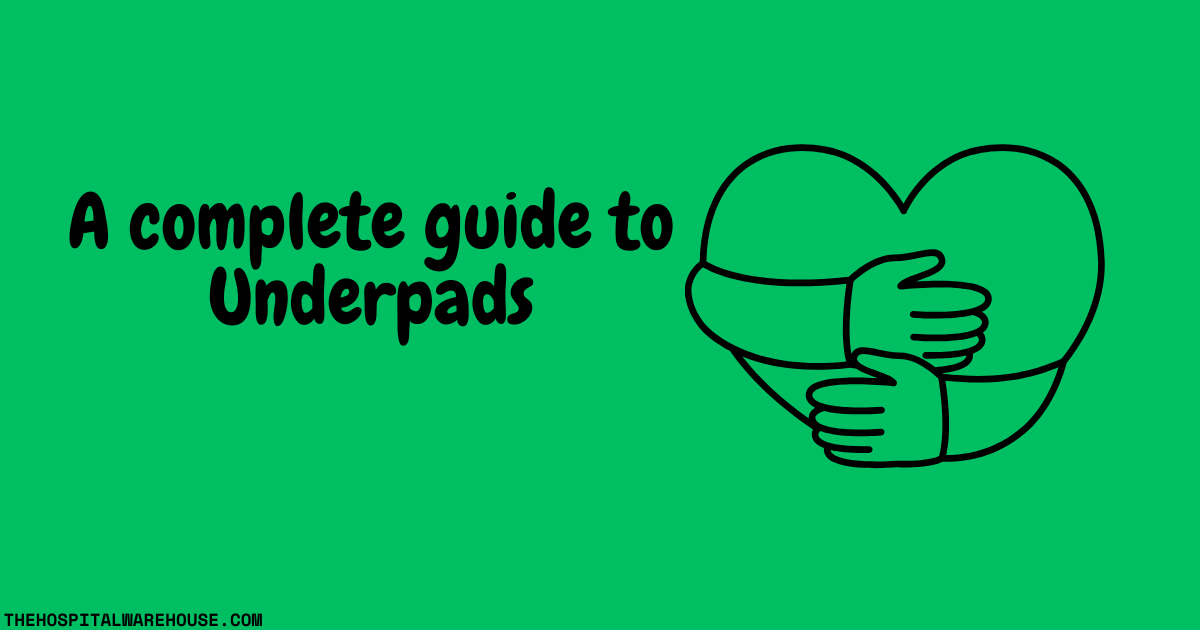
What Are Underpads and Who Needs Them? A Complete Guide to Incontinence Protection
When it comes to incontinence care and personal hygiene, finding the right products can make all the difference in comfort, dignity, and quality of life. Whether you're caring for an elderly parent, recovering from surgery, or managing your own health needs, underpads are often an overlooked but essential tool in maintaining cleanliness and comfort.
If you've never heard of underpads before, or you're wondering whether they might be helpful for your situation, you're in the right place. In this comprehensive guide, we'll explore everything you need to know about underpads, from what they are and how they work to who can benefit from using them.
What Are Underpads?
Underpads, also known as bed pads, chux, or incontinence pads, are absorbent protective sheets designed to safeguard surfaces from moisture and leaks. Think of them as a protective barrier that sits between a person and their bed, chair, or other furniture.
How Underpads Work
The typical underpad features a three-layer construction:
- Absorbent top layer: A soft, comfortable surface that quickly draws moisture away from the skin
- Absorbent core: The middle layer that locks in liquid and prevents it from spreading
- Waterproof backing: A leak-proof bottom layer that protects the surface underneath
Types of Underpads Available
Disposable Underpads: Single-use pads that you throw away after use. These are convenient and hygienic, perfect for situations where washing isn't practical.
Reusable Underpads: Washable pads that can be used multiple times. While they require more maintenance, they're more economical and environmentally friendly for long-term use.
Both types come in various sizes (from small 17"x24" pads to large 36"x36" options) and different absorbency levels to meet specific needs.
Key Functions and Benefits of Underpads
Understanding the benefits of underpads can help you decide if they're right for your situation:
Surface Protection: The primary function is protecting mattresses, chairs, and other surfaces from moisture damage, stains, and odors that can be costly to clean or replace.
Improved Hygiene: Underpads create a cleaner environment by containing leaks and reducing the spread of bacteria and odors.
Reduced Laundry: By protecting bedding and furniture, underpads significantly cut down on the amount of washing required, saving time and energy.
Skin Health: Quality underpads keep moisture away from the skin, reducing the risk of rashes, irritation, and pressure sores.
Caregiver Convenience: They make cleanup quick and easy, reducing stress for both caregivers and care recipients.
Enhanced Features: Many modern underpads include odor control technology, non-slip backing, and breathable materials for added comfort.
Who Needs Underpads?
Underpads aren't just for one specific group of people. They serve a variety of needs across different life situations and age groups.
Elderly Individuals with Incontinence
For seniors dealing with bladder or bowel incontinence, underpads work as an excellent supplement to adult diapers. They provide an extra layer of protection, especially during nighttime when leaks are more likely to occur during sleep. Many elderly individuals find that using underpads gives them confidence to sleep more soundly, knowing their mattress is protected.
Bedridden or Immobile Patients
People who spend extended periods in bed due to illness, injury, or mobility issues benefit greatly from underpads. These pads help prevent pressure sores by keeping the skin dry and comfortable. They also maintain cleaner bedding between diaper or clothing changes, which is crucial for preventing infections and maintaining dignity.
Post-Surgery Patients
Recovery from surgery often involves limited mobility and potential for minor leaks or wound drainage. Whether recovering in the hospital or at home, underpads provide peace of mind and practical protection during the healing process. They're particularly helpful for procedures involving the abdominal area, hip surgeries, or any operation that affects mobility.
Maternity and Postpartum Care
New mothers dealing with postpartum bleeding (lochia) find underpads invaluable during recovery. They're more comfortable than towels and more hygienic than regular bedding protection. Many hospitals provide them during delivery and recovery, and they're equally useful at home during the weeks following childbirth.
Infants and Toddlers
Parents use underpads during diaper changes to protect changing surfaces and for nighttime bed protection as children transition out of diapers. They're also helpful for potty training, providing a safety net during those inevitable accidents.
Pet Owners
While designed for humans, many pet owners discover that underpads work wonderfully for puppy training, lining pet crates, or protecting furniture from elderly pets who may have accidents. They're particularly useful for house-training puppies or caring for senior dogs with incontinence issues.
How to Use Underpads Correctly
Getting the most benefit from underpads requires proper placement and use:
Proper Placement: Position the underpad with the absorbent side facing up and the waterproof backing against the surface you're protecting. For beds, place it where the person's torso and hips will rest.
Securing the Pad: Tuck the edges under the mattress or use the pad over a fitted sheet to prevent bunching. Some people prefer to place a regular sheet over the underpad for added comfort.
Changing Frequency: Disposable underpads should be changed immediately after they become soiled. Reusable pads should be changed when wet and washed according to manufacturer instructions.
Skin Care: Always ensure the person's skin is clean and dry before placing a fresh underpad. This prevents irritation and maintains good hygiene.
Choosing the Right Underpad
Selecting the best underpad depends on several factors:
Size Considerations: Choose a size that adequately covers the area needing protection. Larger isn't always better if it causes bunching, but too small won't provide adequate coverage.
Absorbency Levels: Light absorbency works for minor leaks, while heavy absorbency is necessary for significant incontinence. Consider the person's specific needs and typical volume of leaks.
Material Preferences: Plastic backing is completely waterproof but can feel warm and crinkly. Breathable backing is more comfortable but may not be suitable for heavy incontinence.
Disposable vs. Reusable: Choose disposable for convenience, travel, or temporary needs. Opt for reusable pads for long-term use, environmental concerns, or budget considerations.
Pairing with Other Products: Underpads work excellently alongside adult diapers, waterproof mattress protectors, or incontinence underwear for comprehensive protection.
Making the Right Choice for Your Needs
Underpads are a simple yet effective solution for a wide range of incontinence and hygiene challenges. They provide dignity, comfort, and practical protection for people across all ages and situations. Whether you're caring for a loved one, managing your own health needs, or simply planning ahead, understanding how underpads work can help you make informed decisions about incontinence care.
The key is choosing the right type and size for your specific situation and using them properly to maximize their effectiveness. Remember, there's no shame in needing these products – they're medical supplies designed to improve quality of life and maintain hygiene and comfort.
Ready to find the perfect underpads for your needs? At The Hospital Warehouse, we offer a comprehensive selection of both disposable and reusable underpads in various sizes and absorbency levels. Our high-quality products are designed to keep you clean, dry, and comfortable while protecting your furniture and bedding. Browse our collection today and enjoy fast, discreet delivery right to your door. Your comfort and peace of mind are just a click away!

Leave a comment